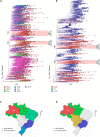Dissemination Dynamics of HIV-1 Subtype B Pandemic and Non-pandemic Lineages Circulating in Amazonas, Brazil
- PMID: 35330760
- PMCID: PMC8940292
- DOI: 10.3389/fmicb.2022.835443
Dissemination Dynamics of HIV-1 Subtype B Pandemic and Non-pandemic Lineages Circulating in Amazonas, Brazil
Abstract
The HIV-1 epidemic in the Amazonas state, as in most of Brazil, is dominated by subtype B. The state, nonetheless, is singular for its significant co-circulation of the variants BCAR, which can mostly be found in the Caribbean region, and BPAN, a clade that emerged in the United States and aggregates almost the totality of subtype B infections world-wide. The Amazonian HIV-1 epidemic provides a unique scenario to compare the epidemic potential of BPAN and BCAR clades spreading in the same population. To reconstruct the spatiotemporal dynamic and demographic history of both subtype B lineages circulating in Amazonas, we analyzed 1,272 HIV-1 pol sequences sampled in that state between 2009 and 2018. Our phylogeographic analyses revealed that while most BCAR infections resulted from a single successful founder event that took place in the Amazonas state around the late 1970s, most BPAN infections resulted from the expansion of multiple clusters seeded in the state since the late 1980s. Our data support the existence of at least four large clusters of the pandemic form in Amazonas, two of them nested in Brazil's largest known subtype B cluster (BBR-I), and two others resulting from new introductions detected here. The reconstruction of the demographic history of the most prevalent BPAN (n = 4) and BCAR (n = 1) clades identified in Amazonas revealed that all clades displayed a continuous expansion [effective reproductive number (R e) > 1] until most recent times. During the period of co-circulation from the late 1990s onward, the Re of Amazonian BPAN and BCAR clusters behaved quite alike, fluctuating between 2.0 and 3.0. These findings support that the BCAR and BPAN variants circulating in the Brazilian state of Amazonas displayed different evolutionary histories, but similar epidemic trajectories and transmissibility over the last two decades, which is consistent with the notion that both subtype B variants display comparable epidemic potential. Our findings also revealed that despite significant advances in the treatment of HIV infections in the Amazonas state, BCAR and BPAN variants continue to expand and show no signs of the epidemic stabilization observed in other parts of the country.
Keywords: Amazonas; Brazil; HIV-1; phylodynamics; subtype B.
Copyright © 2022 Arantes, Gräf, Andrade, Oliveira Chaves, Guimarães and Bello.
Conflict of interest statement
The authors declare that the research was conducted in the absence of any commercial or financial relationships that could be construed as a potential conflict of interest.
Figures




Similar articles
-
Reconstructing the Dissemination Dynamics of the Major HIV-1 Subtype B Non-Pandemic Lineage Circulating in Brazil.Viruses. 2019 Oct 1;11(10):909. doi: 10.3390/v11100909. Viruses. 2019. PMID: 31581471 Free PMC article.
-
High Prevalence and Onward Transmission of Non-Pandemic HIV-1 Subtype B Clades in Northern and Northeastern Brazilian Regions.PLoS One. 2016 Sep 7;11(9):e0162112. doi: 10.1371/journal.pone.0162112. eCollection 2016. PLoS One. 2016. PMID: 27603317 Free PMC article.
-
Spatiotemporal dynamics of dissemination of non-pandemic HIV-1 subtype B clades in the Caribbean region.PLoS One. 2014 Aug 22;9(8):e106045. doi: 10.1371/journal.pone.0106045. eCollection 2014. PLoS One. 2014. PMID: 25148215 Free PMC article.
-
Reviewing the history of HIV-1: spread of subtype B in the Americas.PLoS One. 2011;6(11):e27489. doi: 10.1371/journal.pone.0027489. Epub 2011 Nov 23. PLoS One. 2011. PMID: 22132104 Free PMC article. Review.
-
Molecular epidemiology of HIV-1 infection in Europe: An overview.Infect Genet Evol. 2016 Dec;46:180-189. doi: 10.1016/j.meegid.2016.06.033. Epub 2016 Jun 16. Infect Genet Evol. 2016. PMID: 27321440 Review.
Cited by
-
Association between cytokine and increased risk of death in ART- naïve and ART-non-adherence patients hospitalized with advanced HIV disease.BMC Infect Dis. 2025 Feb 9;25(1):197. doi: 10.1186/s12879-024-10260-z. BMC Infect Dis. 2025. PMID: 39924485 Free PMC article.
References
-
- Bello G., Arantes I., Lacoste V., Ouka M., Boncy J., Césaire R., et al. (2019). Phylogeographic Analyses Reveal the Early Expansion and Frequent Bidirectional Cross-Border Transmissions of Non-pandemic HIV-1 Subtype B Strains in Hispaniola. Front. Microbiol. 10:1340. 10.3389/fmicb.2019.01340 - DOI - PMC - PubMed
LinkOut - more resources
Full Text Sources

